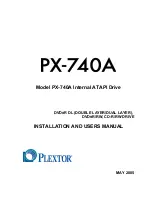
Preset reference
A defined preset reference to be set from -100% to +100%
of the reference range. Selection of 8 preset references via
the digital terminals.
Pulse reference
A pulse frequency signal transmitted to the digital inputs
(terminal 29 or 33).
Ref
MAX
Determines the relationship between the reference input
at 100% full scale value (typically 10 V, 20 mA) and the
resulting reference. The maximum reference value is set in
3-03 Maximum Reference
.
Ref
MIN
Determines the relationship between the reference input
at 0% value (typically 0 V, 0 mA, 4 mA) and the resulting
reference. The minimum reference value is set in
3-02 Minimum Reference
.
1.2.5 Miscellaneous
Analog inputs
The analog inputs are used for controlling various
functions of the frequency converter.
There are 2 types of analog inputs:
•
Current input, 0–20 mA and 4–20 mA
•
Voltage input, 0 to +10 V DC
Analog outputs
The analog outputs can supply a signal of 0–20 mA, 4–20
mA.
Automatic Motor Adaptation, AMA
AMA algorithm determines the electrical parameters for
the connected motor at standstill.
Brake resistor
The brake resistor is a module capable of absorbing the
brake power generated in regenerative braking. This
regenerative braking power increases the intermediate
circuit voltage and a brake chopper ensures that the
power is transmitted to the brake resistor.
CT characteristics
Constant torque characteristics used for all applications
such as conveyor belts, displacement pumps and cranes.
Digital inputs
The digital inputs can be used for controlling various
functions of the frequency converter.
Digital outputs
The frequency converter features 2 solid-state outputs that
can supply a 24 V DC (maximum 40 mA) signal.
DSP
Digital signal processor.
ETR
Electronic thermal relay is a thermal load calculation based
on present load and time. Its purpose is to estimate the
motor temperature.
FC standard bus
Includes RS485 bus with FC protocol or MC protocol. See
8-30 Protocol
.
Initialising
If initialising is carried out (
14-22 Operation Mode
), the
frequency converter returns to the default setting.
Intermittent duty cycle
An intermittent duty rating refers to a sequence of duty
cycles. Each cycle consists of an on-load and an off-load
period. The operation can be either periodic duty or non-
periodic duty.
LCP
The local control panel makes up a complete interface for
control and programming of the frequency converter. The
control panel is detachable and can be installed up to 3 m
from the frequency converter, i.e. in a front panel with the
installation kit option.
NLCP
The numerical local control panel interface for control and
programming of the frequency converter. The display is
numerical and the panel is used to display process values.
The NLCP has storing and copy functions.
lsb
Least significant bit.
msb
Most significant bit.
MCM
Short for Mille Circular Mil, an American measuring unit for
cable cross-section. 1 MCM = 0.5067 mm
2
.
On-line/Off-line parameters
Changes to on-line parameters are activated immediately
after the data value is changed. Press [OK] to activate
changes to off-line parameters.
Process PID
The PID control maintains the desired speed, pressure,
temperature, etc. by adjusting the output frequency to
match the varying load.
PCD
Process control data
Power cycle
Switch off the mains until display (LCP) is dark, then turn
power on again.
Power factor
The power factor is the relation between I
1
and I
RMS
.
Power factor = 3 x U x I1 cosϕ1
3
x U x IRMS
For FC 360 frequency converters,
cosϕ
1
=1, therefore:
Power factor = I1 x cosϕ1
IRMS
= I1
IRMS
Introduction
Design Guide
MG06B402
Danfoss A/S © 09/2014 All rights reserved.
7
1
1










































